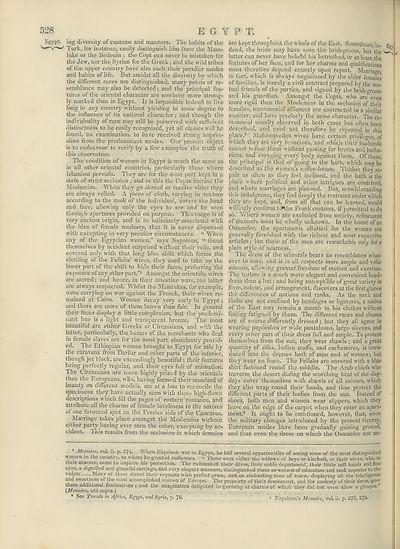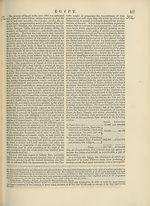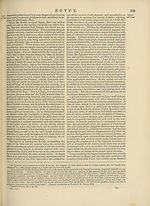Encyclopaedia Britannica > Volume 8, DIA-England
(538) Page 528
Download files
Complete book:
Individual page:
Thumbnail gallery: Grid view | List view

J
l-
li. I
Egypt, ing diversity of customs and manners. The habits of the
Turk, for instance, easily distinguish him from the Mam-
luke or the Bedouin ; the Copt can never be mistaken for
the Jew, nor the Syrian for the Greek; and the wild tribes
of the upper country have also each their peculiar modes
and habits of life. But amidst all the diversity by which
the different races are distinguished, many points of re¬
semblance may also be detected; and the principal fea¬
tures of the oriental character are nowhere more strong¬
ly marked than in Egypt. It is impossible indeed to live
long in any country without yielding in some degree to
the influence of its national character; and though the
individuality of race may still be preserved with sufficient
distinctness to be easily recognised, yet all classes will be
found, on examination, to have received strong impres¬
sions from the predominant modes. Our present object
is to endeavour to verify by a few examples the truth of
this observation.
The condition of women in Egypt is much the same as
in all other oriental countries, particularly those where
I slam ism prevails. They are for the most part kept in a
state of strict seclusion ; and in this the Copts imitate the
Moslemins. When they go abroad or receive visits they
are always veiled. A piece of cloth, varying in texture
according to the rank of the individual, covers the head
and face, allowing only the eyes to see and be seen
through apertures provided on purpose. This usage is of
very ancient origin, and is so intimately associated with
the idea of female modesty, that it is never dispensed
with excepting in very peculiar circumstances. “ When
any of the Egyptian women,” says Napoleon, “ found
themselves by accident surprised without their veils, and
covered only with that long blue shift which forms the
clothing of the Fellahs’ wives, they used to take up the
lower part of the shift to hide their faces, preferring the
exposure of any other part.”1 Amongst the orientals, wives
are sacred; and hence, in their intestine wars, the latter
are always respected. Whilst the Mamlukes, for example,
were carrying on war against the French, their wives re¬
mained at Cairo. Women decay very early in Egypt;
and there are more of them brown than fair. In general
their faces display a little complexion, but the predomi¬
nant hue is a light and transparent bronze. The most
beautiful are either Greeks or Circassians, and with the
latter, particularly, the bazars of the merchants who deal
in female slaves are for the most part abundantly provid¬
ed. The Ethiopian women brought to Egypt for sale by
the caravans from Darfur and other parts of the interior,
though jet black, are exceedingly beautiful; their features
being perfectly regular, and their eyes full of animation.
The Circassians are more highly prized by the orientals
than the Europeans, who, having formed their standard of
beauty on different models, are at a loss to reconcile the
specimens they have actually seen with those high-flown
descriptions which fill the pages of eastern romance, and
attribute all the charms of female loveliness to the natives
of one favoured spot on the Persian side of the Caucasus.
Marriage takes place amongst the Moslemins without
either party having ever seen the other, excepting by ac¬
cident. This results from the seclusion in which females
are kept throughout the whole of the East. Sometimes in¬
deed, the bride may have seen the bridegroom, but the
latter can never have behe'ld his betrothed, or at least the
features of her face, and for her charms and qualifications
must therefore depend entirely upon report. Marriage,
in fact, which is always negociated by the elder females
of families, is merely a civil contract prepared by the mu¬
tual friends of the parties, and signed by the bridegroom
and his guardian. Amongst the Copts, who are*3 even
more rigid than the Moslemins in the seclusion of their
females, matrimonial alliances are contracted in a similar
manner, and have precisely the same character. The ce¬
remonial usually observed in both cases has often been
described, and need not therefore be repeated in this
place.2 Mahommedan wives have certain privileges, of
which they are very tenacious, and which their husbands
cannot refuse them without passing for brutes and barba¬
rians, and enraging every body against them. Of these,
the principal is that of going to the bath, which may be
described as the women’s coffee-house. Thither they re¬
pair as often as they feel inclined, and the bath is the
place where political and other intrigues are contrived,
and where marriages are planned. But, notwithstanding
this indulgence, they feel deeply the restraint under which
they are kept, and, from all that can be learned, would
willingly conform teethe Frank customs, if permitted to do
so. Where women are excluded from society, refinement
of manners must be wholly unknown. In the house of an
Osmanlee, the apartments allotted for the women are
generally furnished with the richest and most expensive
articles; but those of the men are remarkable only for a
plain style of neatness.
The dress of the orientals bears no resemblance what¬
ever to ours, and is in all respects more ample and volu¬
minous, allowing greater freedom of motion and exertion.
The turban is a much more elegant and convenient head¬
dress than a hat; and being susceptible of great variety in
form, colour, and arrangement, discovers at the first glance
the differences of nations and ranks. As the neck and
limbs are not confined by bandages or ligatures, a native
of the East may remain a month in his clothes without
feeling fatigued by them. The different races and classes
are of course differently dressed ; but they all agree in
wearing papooshes or wide pantaloons, large sleeves, and
every other part of their dress full and ample. To protect
themselves from the sun, they wear shawls ; and a great
quantity of silks, Indian stuffs, and cachemires, is intro¬
duced into the dresses both of men and of women; but
they wear no linen. The Fellahs are covered with a blue
shirt fastened round the middle. The Arab chiefs who
traverse the desert during the scorching heat of the dog-
days cover themselves with shawls of all colours, which
they also wrap round their heads, and thus protect the
different parts of their bodies from the sun. Instead of
shoes, both men and women wear slippers, which they
leave on the edge of the carpet when they enter an apart¬
ment.3 It ought to be mentioned, however, that, since
the military changes introduced by the present viceroy,
European modes have been gradually gaining ground,
and that even the dress on which the Osmanlee not un-
^ j emoirs, vol. 11. p. 2/4. Vv hen Napoleon was in Egypt, he had several opportunities of seeing some of the most distinguished
women in the country, to whom he granted audiences. “ These were either the widows of beys or kiachefs, or their wives, who, in
their absence, came to implore his protection. The richness of their dress, their noble deportment, their little soft hands and fine
eyes, a dignined and giaceiul carriage, and very elegant manners, distinguished them as women of education and rank superior to the
' ulnai Many ol them stated their requests with perfect grace, and an enchanting tone of voice, displaving all the intelligence
and sweetness of the most accomplished .women of Europe. The propriety of their demeanour, and the modesty of their dress, gave
them additional fascinations ; and the imagination delighted in guessing at charms of which thev did not even allow a glimpse.”
[Memoirs, ubi supra.)
See Travels in Africa, Egypt, and Syria, p. 70‘. 3 Napoleon’s Memoirs, vol. ii. p. 278, 279>
l-
li. I
Egypt, ing diversity of customs and manners. The habits of the
Turk, for instance, easily distinguish him from the Mam-
luke or the Bedouin ; the Copt can never be mistaken for
the Jew, nor the Syrian for the Greek; and the wild tribes
of the upper country have also each their peculiar modes
and habits of life. But amidst all the diversity by which
the different races are distinguished, many points of re¬
semblance may also be detected; and the principal fea¬
tures of the oriental character are nowhere more strong¬
ly marked than in Egypt. It is impossible indeed to live
long in any country without yielding in some degree to
the influence of its national character; and though the
individuality of race may still be preserved with sufficient
distinctness to be easily recognised, yet all classes will be
found, on examination, to have received strong impres¬
sions from the predominant modes. Our present object
is to endeavour to verify by a few examples the truth of
this observation.
The condition of women in Egypt is much the same as
in all other oriental countries, particularly those where
I slam ism prevails. They are for the most part kept in a
state of strict seclusion ; and in this the Copts imitate the
Moslemins. When they go abroad or receive visits they
are always veiled. A piece of cloth, varying in texture
according to the rank of the individual, covers the head
and face, allowing only the eyes to see and be seen
through apertures provided on purpose. This usage is of
very ancient origin, and is so intimately associated with
the idea of female modesty, that it is never dispensed
with excepting in very peculiar circumstances. “ When
any of the Egyptian women,” says Napoleon, “ found
themselves by accident surprised without their veils, and
covered only with that long blue shift which forms the
clothing of the Fellahs’ wives, they used to take up the
lower part of the shift to hide their faces, preferring the
exposure of any other part.”1 Amongst the orientals, wives
are sacred; and hence, in their intestine wars, the latter
are always respected. Whilst the Mamlukes, for example,
were carrying on war against the French, their wives re¬
mained at Cairo. Women decay very early in Egypt;
and there are more of them brown than fair. In general
their faces display a little complexion, but the predomi¬
nant hue is a light and transparent bronze. The most
beautiful are either Greeks or Circassians, and with the
latter, particularly, the bazars of the merchants who deal
in female slaves are for the most part abundantly provid¬
ed. The Ethiopian women brought to Egypt for sale by
the caravans from Darfur and other parts of the interior,
though jet black, are exceedingly beautiful; their features
being perfectly regular, and their eyes full of animation.
The Circassians are more highly prized by the orientals
than the Europeans, who, having formed their standard of
beauty on different models, are at a loss to reconcile the
specimens they have actually seen with those high-flown
descriptions which fill the pages of eastern romance, and
attribute all the charms of female loveliness to the natives
of one favoured spot on the Persian side of the Caucasus.
Marriage takes place amongst the Moslemins without
either party having ever seen the other, excepting by ac¬
cident. This results from the seclusion in which females
are kept throughout the whole of the East. Sometimes in¬
deed, the bride may have seen the bridegroom, but the
latter can never have behe'ld his betrothed, or at least the
features of her face, and for her charms and qualifications
must therefore depend entirely upon report. Marriage,
in fact, which is always negociated by the elder females
of families, is merely a civil contract prepared by the mu¬
tual friends of the parties, and signed by the bridegroom
and his guardian. Amongst the Copts, who are*3 even
more rigid than the Moslemins in the seclusion of their
females, matrimonial alliances are contracted in a similar
manner, and have precisely the same character. The ce¬
remonial usually observed in both cases has often been
described, and need not therefore be repeated in this
place.2 Mahommedan wives have certain privileges, of
which they are very tenacious, and which their husbands
cannot refuse them without passing for brutes and barba¬
rians, and enraging every body against them. Of these,
the principal is that of going to the bath, which may be
described as the women’s coffee-house. Thither they re¬
pair as often as they feel inclined, and the bath is the
place where political and other intrigues are contrived,
and where marriages are planned. But, notwithstanding
this indulgence, they feel deeply the restraint under which
they are kept, and, from all that can be learned, would
willingly conform teethe Frank customs, if permitted to do
so. Where women are excluded from society, refinement
of manners must be wholly unknown. In the house of an
Osmanlee, the apartments allotted for the women are
generally furnished with the richest and most expensive
articles; but those of the men are remarkable only for a
plain style of neatness.
The dress of the orientals bears no resemblance what¬
ever to ours, and is in all respects more ample and volu¬
minous, allowing greater freedom of motion and exertion.
The turban is a much more elegant and convenient head¬
dress than a hat; and being susceptible of great variety in
form, colour, and arrangement, discovers at the first glance
the differences of nations and ranks. As the neck and
limbs are not confined by bandages or ligatures, a native
of the East may remain a month in his clothes without
feeling fatigued by them. The different races and classes
are of course differently dressed ; but they all agree in
wearing papooshes or wide pantaloons, large sleeves, and
every other part of their dress full and ample. To protect
themselves from the sun, they wear shawls ; and a great
quantity of silks, Indian stuffs, and cachemires, is intro¬
duced into the dresses both of men and of women; but
they wear no linen. The Fellahs are covered with a blue
shirt fastened round the middle. The Arab chiefs who
traverse the desert during the scorching heat of the dog-
days cover themselves with shawls of all colours, which
they also wrap round their heads, and thus protect the
different parts of their bodies from the sun. Instead of
shoes, both men and women wear slippers, which they
leave on the edge of the carpet when they enter an apart¬
ment.3 It ought to be mentioned, however, that, since
the military changes introduced by the present viceroy,
European modes have been gradually gaining ground,
and that even the dress on which the Osmanlee not un-
^ j emoirs, vol. 11. p. 2/4. Vv hen Napoleon was in Egypt, he had several opportunities of seeing some of the most distinguished
women in the country, to whom he granted audiences. “ These were either the widows of beys or kiachefs, or their wives, who, in
their absence, came to implore his protection. The richness of their dress, their noble deportment, their little soft hands and fine
eyes, a dignined and giaceiul carriage, and very elegant manners, distinguished them as women of education and rank superior to the
' ulnai Many ol them stated their requests with perfect grace, and an enchanting tone of voice, displaving all the intelligence
and sweetness of the most accomplished .women of Europe. The propriety of their demeanour, and the modesty of their dress, gave
them additional fascinations ; and the imagination delighted in guessing at charms of which thev did not even allow a glimpse.”
[Memoirs, ubi supra.)
See Travels in Africa, Egypt, and Syria, p. 70‘. 3 Napoleon’s Memoirs, vol. ii. p. 278, 279>
Set display mode to:
![]() Universal Viewer |
Universal Viewer | ![]() Mirador |
Large image | Transcription
Mirador |
Large image | Transcription
Images and transcriptions on this page, including medium image downloads, may be used under the Creative Commons Attribution 4.0 International Licence unless otherwise stated. ![]()
| Encyclopaedia Britannica > Encyclopaedia Britannica > Volume 8, DIA-England > (538) Page 528 |
|---|
| Permanent URL | https://digital.nls.uk/193329999 |
|---|
| Attribution and copyright: |
|
|---|
| Description | Ten editions of 'Encyclopaedia Britannica', issued from 1768-1903, in 231 volumes. Originally issued in 100 weekly parts (3 volumes) between 1768 and 1771 by publishers: Colin Macfarquhar and Andrew Bell (Edinburgh); editor: William Smellie: engraver: Andrew Bell. Expanded editions in the 19th century featured more volumes and contributions from leading experts in their fields. Managed and published in Edinburgh up to the 9th edition (25 volumes, from 1875-1889); the 10th edition (1902-1903) re-issued the 9th edition, with 11 supplementary volumes. |
|---|---|
| Additional NLS resources: |
|

